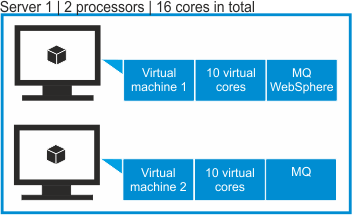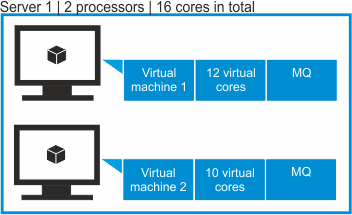Virtual processor core (VPC)
![]() Available from 9.2.11.
Available from 9.2.11.
A virtual processor core (VPC) is a unit
of measurement that is used to determine the licensing cost of IBM products. It is based on the
number of virtual cores (vCPUs) that are available to the product. A vCPU is a virtual core that is
assigned to a virtual machine or a physical processor core if the server is not partitioned for
virtual machines.
For information about rules of subcapacity counting on each virtualization type, see: Virtualization Capacity License Counting Rules. For information about rules of subcapacity counting on public clouds, see: IBM Eligible Public Cloud BYOSL policy.
 Fixed VPC value
Fixed VPC value
The licensing model of some IBM products defines that product instances consume a fixed number of VPCs, for example when they run in the warm standby mode. To report metric utilization by such product instances, assign them with the VPC Warm Standby metric. For more information, see: Fixed PVU and VPC values for instances running in the warm standby mode.
Scenarios
The following scenarios describe how the number of vCPUs is counted under different circumstances. The calculations are based on sample values and should be treated as examples.
- Scenario 1: VPC on a physical server
- IBM MQ software is installed on a server that has two processors. Each processor has 8 physical
cores which gives 16 cores in total. The number of vCPUs to license is 16.

- Scenario 2: VPC on two virtual machines
-
Two VMs are deployed on a server that has two processors. Each processor has 8 physical cores which gives 16 cores in total. Each VM is assigned 10 vCPUs.
WebSphere software is installed only on the first VM and has access to 10 vCPUs. The number of vCPUs to license is 10. IBM MQ software is installed on both VMs and thus has access to 20 vCPUs. Because the number of physical cores is lower than the number of vCPUs that are assigned to the VMs, the number of vCPUs to license is capped to 16.

- Scenario 3: VPC in a virtual environment where the VM manager is not defined
-
Important: In this scenario, default subcapacity counting is applied due to the lack of connection to the VM manager. IBM accepts audit reports that contain subcapacity values calculated based on the default subcapacity counting instead of considering the client to be ineligible for subcapacity or liable for full capacity. For more information, see: Default subcapacity counting and Managing VM managers.
Two VMs are deployed on a server that has two processors. Each processor has 8 cores which gives 16 physical cores in total. The first VM is assigned 12 vCPUs. The second VM is assigned 10 vCPUs. It gives 22 vCPUs in total. IBM MQ software is installed on both VMs.

If a connection to the VM manager is not defined, License Metric Tool does not have access to information about the number of sockets and physical cores on the server on which the VMs are deployed. It has access only to information about the number of vCPUs that each VM is assigned. The sum of vCPUs to which IBM MQ software has access is greater than the number of physical cores that are available on the server.
If a connection to the VM manager is not defined, the number of vCPUs to license is 22. If the connection is defined, 22 vCPUs are capped to 16 physical cores and thus the number of vCPUs to license is 16.